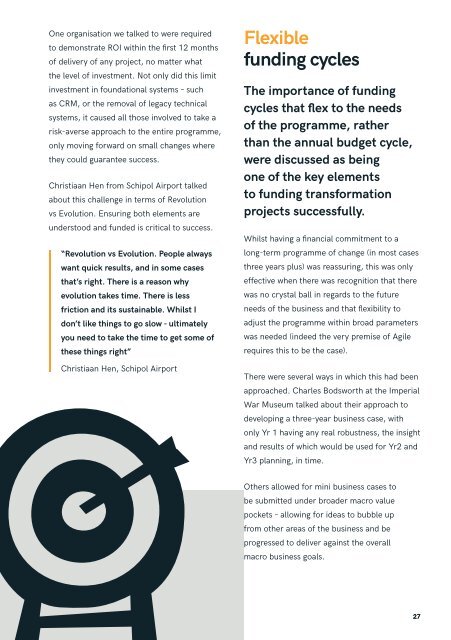GS_Transformation_report_6-Single-Pages
You also want an ePaper? Increase the reach of your titles
YUMPU automatically turns print PDFs into web optimized ePapers that Google loves.
One organisation we talked to were required<br />
to demonstrate ROI within the first 12 months<br />
of delivery of any project, no matter what<br />
the level of investment. Not only did this limit<br />
investment in foundational systems – such<br />
as CRM, or the removal of legacy technical<br />
systems, it caused all those involved to take a<br />
risk-averse approach to the entire programme,<br />
only moving forward on small changes where<br />
they could guarantee success.<br />
Christiaan Hen from Schipol Airport talked<br />
about this challenge in terms of Revolution<br />
vs Evolution. Ensuring both elements are<br />
understood and funded is critical to success.<br />
“Revolution vs Evolution. People always<br />
want quick results, and in some cases<br />
that’s right. There is a reason why<br />
evolution takes time. There is less<br />
friction and its sustainable. Whilst I<br />
don’t like things to go slow - ultimately<br />
you need to take the time to get some of<br />
these things right”<br />
Christiaan Hen, Schipol Airport<br />
Flexible<br />
funding cycles<br />
The importance of funding<br />
cycles that flex to the needs<br />
of the programme, rather<br />
than the annual budget cycle,<br />
were discussed as being<br />
one of the key elements<br />
to funding transformation<br />
projects successfully.<br />
Whilst having a financial commitment to a<br />
long-term programme of change (in most cases<br />
three years plus) was reassuring, this was only<br />
effective when there was recognition that there<br />
was no crystal ball in regards to the future<br />
needs of the business and that flexibility to<br />
adjust the programme within broad parameters<br />
was needed (indeed the very premise of Agile<br />
requires this to be the case).<br />
There were several ways in which this had been<br />
approached. Charles Bodsworth at the Imperial<br />
War Museum talked about their approach to<br />
developing a three-year business case, with<br />
only Yr 1 having any real robustness, the insight<br />
and results of which would be used for Yr2 and<br />
Yr3 planning, in time.<br />
Others allowed for mini business cases to<br />
be submitted under broader macro value<br />
pockets – allowing for ideas to bubble up<br />
from other areas of the business and be<br />
progressed to deliver against the overall<br />
macro business goals.<br />
27


